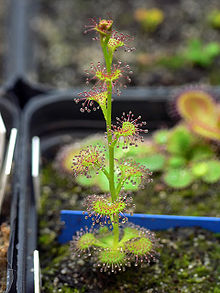Drosera platypoda
| Drosera platypoda | ||||||||||||
|---|---|---|---|---|---|---|---|---|---|---|---|---|

Drosera platypoda , inflorescence |
||||||||||||
| Systematics | ||||||||||||
|
||||||||||||
| Scientific name | ||||||||||||
| Drosera platypoda | ||||||||||||
| Turcz. |
Drosera platypoda is a carnivorous plant of the genus sundew ( Drosera ). It belongs to the so-called "tuberous drosera", a group of sundew from southwestern Western Australia that forms tubers as persistence organs.
description
Drosera platypoda is a perennial , herbaceous plant that grows from an orange-colored, inverted egg-shaped and laterally slightly flattened tuber measuring up to 10 centimeters long and 7 millimeters in diameter, around which, as remains of previous years, brown, papery sheaths and old root fibers lie. The subterranean runners reach up to 18 centimeters in length, but are rarely completely horizontal, and under good conditions daughter tubers form on them.
The 15 to 20 centimeters high, unbranched and - unusual for the section - individual stems are hairless and upright, with a flat, down-to-earth rosette at their base. The leaves of this rosette are stalked, the stem reaches a length of 5 to 9 millimeters, is flattened (0.5 to 2 millimeters thick) and broadened (1 to 3 millimeters). Towards the end, the upper side of the leaves is covered with somewhat longer, centrally shorter catching tentacles. The leaf blades are fan-shaped, 2.5 to 5 millimeters long and 4 to 9 millimeters wide. The leaves on the stem are arranged alternately, in shape and size of the same shape as those of the rosette, but more clearly curved along their length and increasingly more upright towards the tip, resulting in a conical habit.
The flowering period is from August to November, and summer bush fires usually trigger mass blooms. The hairless inflorescence axis bears a simple raceme or a two- to four-way branched umbrella panicle , mostly terminal and 7 to 12 centimeters long and with 8 to 35 flowers. The flower stalks are hairless and 5 to 10 millimeters long. The sepals are green, broadly ovate and pointed and reach a length of 3.5 to 4.5 millimeters and a width of 1.5 to 3 millimeters, the edges are simple, rarely weakly serrated at the tip, densely covered with black dots and fine papillae . The petals are inverted ovate, blunt and slightly notched at the tip. Their basic color is white, they are 7.5 to 10 millimeters long and 5 to 8 millimeters wide. The five stamens are between 2.5 and 3 millimeters long and completely white, the pollen is yellow. The dark red ovary is approximately round, papilose, almost 1 millimeter long and has a diameter of around 1.8 millimeters in the flowering period, the three carpels are two-lobed. The three styluses are white and tinted red at the base, they are a total of around 1.5 millimeters long and divided into many sections at the base, sometimes repeated. The scars are rounded and slightly thickened.
The capsule fruit is inverted egg-shaped with a diameter of 3 to 3.5 millimeters and contains around 100 dark brown, irregular, but tortuous seeds that measure 0.5 to 0.7 millimeters long and 0.4 to 0.5 millimeters in diameter and are provided with a reticulated, irregularly grooved surface.
Distribution, locations, endangerment
The species is native to Western Australia in the area between Manjimup , Scott River and Cape Riche . The locations are wet in winter and completely dry in summer in the heathland under low bushes and in winter wet peat-sand soils on slopes of stony loam. The stocks can include numerous individuals. The species is often found in its range and sometimes also in national parks, so it is considered harmless.
Systematics
Drosera platypoda was first described by Nikolai Turtschaninow in 1854 , the specific epithet means something like "flat-footed" and refers to the rosette lying flat on the ground from which the stem grows. Drosera platypoda is part of the Stoloniferae section in the subgenus Ergaleium , Turczaninow had already classified it in the sub-series at that time.
Molecular genetic studies showed Drosera platypoda as a sister of a clade from Drosera stolonifera and Drosera prostratoscaposa .
literature
- Allen Lowrie: A taxonomic revision of Drosera section Stolonifera (Droseraceae), from south-west Western Australia. In: Nuytsia . Vol. 15, No. 3, 2005, pp. 355-393 .
Individual evidence
- ^ A b Allen Lowrie: Carnivorous Plants of Australia. Volume 1. University of Western Australia Press, Nedlands 1987, ISBN 0-85564-253-X , p. 116.
- Jump up ↑ Allen Lowrie: A taxonomic revision of Drosera section Stolonifera (Droseraceae), from south-west Western Australia. In: Nuytsia. Vol. 15, No. 3, 2005, pp. 355-393.
- ↑ Ludwig Diels : Droseraceae (= The Plant Kingdom . 26 = 4, 112, ZDB -ID 846151-x ). Engelmann, Leipzig 1906, p. 128.
- ↑ Fernando Rivadavia, Katsuhiko Kondo, Masahiro Kato and Mitsuyasu Hasebe: Phylogeny of the Sundews, Drosera (Droseraceae), Based on Chloroplast rbcL and Nuclear 18S Ribosomal DNA Sequences. In: American Journal of Botany. Vol. 90, No. 1, 2003, ISSN 0002-9122 , pp. 123-130, JSTOR 4122732 .
